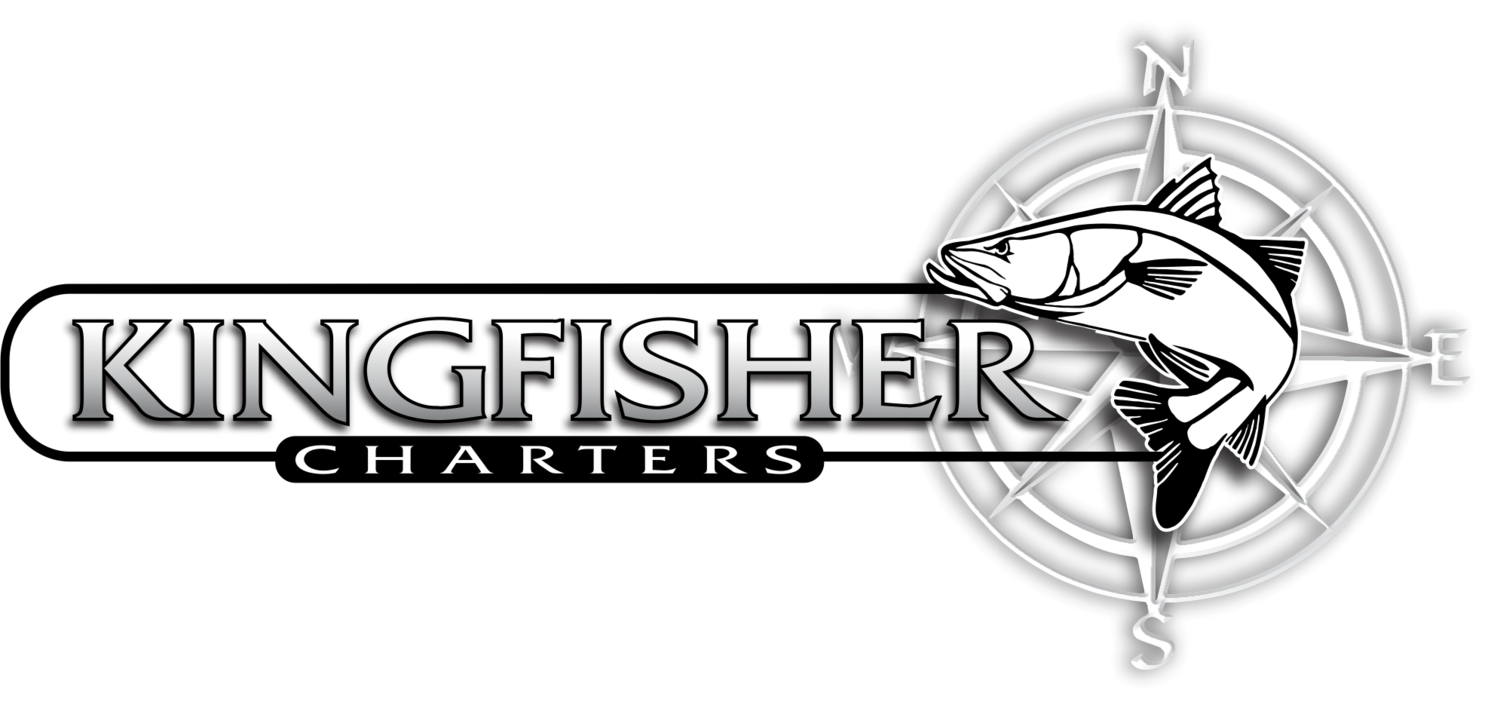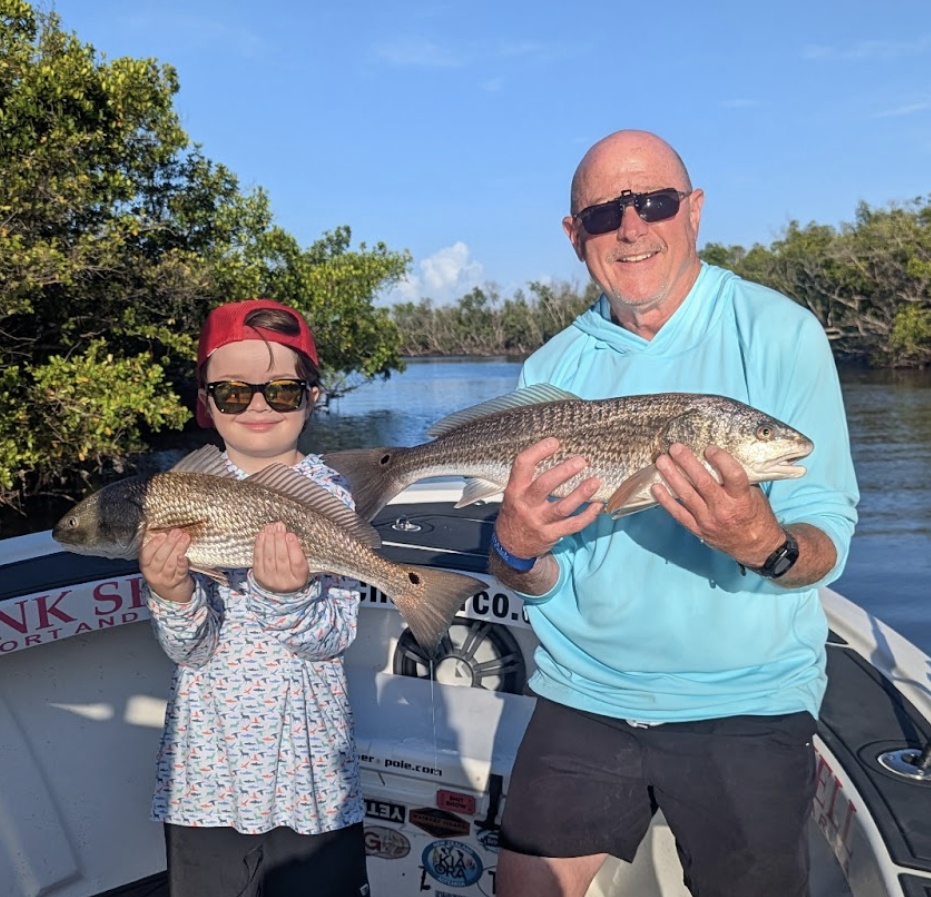Late summer brings a distinct shift across the inshore waters of Sanibel, Captiva, and Fort Myers. Water levels stay high throughout most of the day, grasslines remain submerged longer, and tidal flow intensifies with the incoming influence of storm season. This is a stretch of time where resident fish feed more aggressively in condensed windows, and visitors to the fishery, both human and finned, converge around current, bait, and cover.
KingFisher Charters works every inch of this ecosystem, from the oyster-laden creeks behind Pine Island to the dock-lined cuts of the Caloosahatchee. Every shoreline tells a different story in late summer, and every tide redraws the rules.
Redfish Push Into the Grass and Patrol the Edges
Redfish in this region are fully locked into their summertime holding patterns, but with pressure mounting from boat traffic and high sun, they shift more frequently between shallow ambush zones and deeper edges. Flooded mangrove shorelines in southern Matlacha and Sanibel’s sheltered coves are prime staging areas, especially during late morning highs.
Signs and Triggers
Crushed mangrove seed pods and mud puffs along the edge indicate recent redfish feeding
Mullet schools pushing outward into open grass often signal reds moving in beneath
Redfish are most aggressive on a dropping tide following midmorning high water
Tactical Adjustments
Cut pinfish or ladyfish dropped along current-swept corners are pulling in mid-slot reds, while topwater plugs fished tight to grass edges before sunup remain productive. In cloudy water, gold spoons cast along shoreline troughs are getting short but violent hits from reds chasing shrimp and crabs flushed by the tide.
Snook Hunt Along Current Breaks and Dock Lines
Late summer snook fishing across the Fort Myers area is shaped by movement. These fish no longer hold on the beaches and are shifting back into transitional creeks, deeper dock systems, and river mouths. The bite is more tide-dependent than time-dependent. Most successful outings center around ambush points where current breaks allow snook to lurk with minimal effort.
Current Patterns Define Structure
Outgoing tides flush bait from inland creeks into Matanzas Pass and the Caloosahatchee, pulling snook into intercept zones
Residential dock lights in the evening draw shrimp, and snook follow
Points where tannin-stained runoff meets cleaner water create temporary feeding shelves
Big snook are showing preference for free-lined whitebait and jumbo live shrimp, especially when fished without added weight. Anglers deploying swim baits or jerk shads should adjust speed based on water clarity and tidal force.
Seatrout Hold on Deeper Grass and Flow Faces
The speckled trout bite is consistent throughout the deeper stretches of Pine Island Sound and between Blind Pass and Tarpon Bay. The larger fish are favoring seagrass beds adjacent to sand patches and minor depth changes, zones where current lifts shrimp and baitfish into short, suspended pulses.
Two Distinct Profiles
Suspended Strike Zones
In clearer water west of Captiva, trout are feeding midway through the column on overcast mornings. Slow-rolled paddle tails and hard suspending baits perform best here.
Bottom-Oriented Feeders
Inside the sound and southern bay complexes, trout school lower, picking off shrimp and small pinfish above grass. Heavier jigheads and short-hop retrieves trigger reaction bites.
Flounder Hug Current-Bent Contours
Flounder in the Fort Myers region are not as widely distributed as other species, but late summer creates specific opportunities. Troughs along the outer edge of Sanibel and deep cuts behind barrier islands funnel enough bait to pull flatfish into ambush position.
Flounder Presentation Tiering
Drag and Drop: Mullet or strip bait on a knocker rig works well near inlet mouths and sloughs
Swim Sweep: Light jigheads tipped with shrimp or curly tails dragged steadily across drop-offs around Redfish Pass
Short-Burst Jigging: ¼ oz bucktails bounced vertically alongside dock pilings and bridge footers on the Sanibel Causeway
Anglers should target slack water on incoming tide for the clearest bottom positioning and strongest commitment from feeding fish.
Sheepshead Stack Deep on Pilings and Barge Rubble
While most associate sheepshead with winter structure fishing, late summer sees a pulse of fish staging around nearshore hardpoints and deeper dock systems. These are post-spawn sheepshead, and they are actively feeding on crustaceans along concrete and barnacle encrustations.
Best Conditions for Targeting
Full or new moon tides that increase vertical access to deeper barnacle lines
Early outgoing tide windows when water clarity improves slightly
Fiddler crabs or sand fleas pitched just outside the main piling line tend to get the quickest bites
Use light gear and minimal terminal weight. Most fish hit on the drop or within seconds of contact with structure.
Mangrove Snapper Are Everywhere
From inside the Caloosahatchee to the far side of Captiva Pass, mangrove snapper dominate the inshore bite. These fish are stacked around dock pilings, mangrove walls, bridge spans, and rock piles. Most are in the 10 to 14 inch range, but larger models are mixed in with the right bait.
Live shrimp free-lined or floated beneath a small cork is the most consistent presentation. Cut pilchards and threadfins work well near moving current and in shadow lines.
Jack Crevalle, Ladyfish, and Bycatch Blitzes
In the evenings, a short burst of chaos often hits the inshore water. Schools of jacks or ladyfish crash bait near channel bends, creek mouths, and spillover basins. These fish are not reliable, but they offer explosive action and useful scouting indicators. Where ladyfish feed, redfish and trout often follow.
Spoons, small topwaters, and fast jigs retrieve well in these situations. Surface activity often lasts under five minutes, so being rigged and ready matters.
Final Movement Before the Fall Turn
As August slips toward September, the inshore waters of Sanibel, Captiva, and Fort Myers concentrate their energy into shorter windows. The tide changes bring stronger current, the bait becomes more erratic, and predators adjust their positions with increasing urgency.
From the mangrove edges at sunrise to the inlet rips by late afternoon, KingFisher Charters covers every relevant transition zone. These final weeks before the first cool front are rich with opportunity, for reds staging in the shadows, snook drifting into ambush spots, and flounder locked tight to bottom structure. The combination of tidal force, bait density, and warm water keeps these fish in active patterns longer than most expect.
This convergence of opportunity is what defines the final leg of summer fishing. The need to cover ground, time the tides, and shift quickly between shoreline and structure becomes central to every trip. Preparation meets spontaneity in these moments. Those looking to stay in rhythm with these conditions should fish them deliberately. KingFisher Charters offers access to that rhythm through firsthand understanding of these waters. That kind of access comes from time spent running these routes daily, tracking bait, and adjusting to pressure shifts before they happen. If that’s the type of precision you're after, book with KingFisher Charters today.




